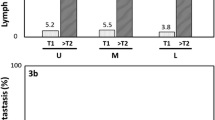Abstract
A total of 530 cases of gastric cancer treated by curative surgery was analyzed with regard to lymph node metastases and survival rate. During this period, curative resections made up 75.9% of all resections (530/698) for gastric cancer, and the 5-year survival rate was 50.6% (268/530). A total of 15,739 regional lymph nodes (an average of 30 per specimen) removed at surgery were examined histologically for metastases, and 16.0% were found to be positive. Of 339 patients with advanced, transmural cancers, 74.9% had lymph node métastases; those with negative nodes had a 5-year survival rate of 63.5%, while those with positive nodes had a 5-year survival rate of 29.9%. The 5-year survivors with positive nodes made up 58.5% of all 5-year survivors. The almost complete removal of at least the primary and secondary lymph node groups draining a gastric neoplasm is an essential part of the curative surgical treatment of gastric cancer. For lesions in the upper and middle portions of the stomach that invade the serosa of the posterior wall, total gastrectomy with a caudal hemipancreatectomy and splenectomy should be aggressively performed, so as to accomplish complete en bloc removal of the lymph nodes in these regions.
Résumé
Nous avons analysé, aux points de vue métastases ganglionnaires et survie, 530 cas de cancers gastriques traités par chirurgie curative. Pendant cette période, les résections à visée curative ont représenté 75.9% de toutes les résections pour cancer gastrique (530/698) et la survie à 5 ans a été de 50.6% (268/530). Au total, 15,739 ganglions régionaux enlevés en cours d'opération (en moyenne 30 par pièce opératoire) ont été examinés: 16.0% renfermaient des métastases. Sur 339 malades avec cancer avancé ayant effracté les limites de l'organe, 74.9% avaient des métastases ganglionnaires; les survies à 5 ans ont été de 63.5% dans les cas sans métastase ganglionnaire et de 29.9% dans les cas avec métastase. Sur l'ensemble des survivants à 5 ans, 58.5% avaient des ganglions envahis. La résection presque totale d'au moins les premier et deuxième relais ganglionnaires drainant le cancer gastrique est un élément essentiel du traitement à visée curatrice. Pour les lésions des tiers supérieur et moyen de l'estomac qui envahissent la séreuse de la paroi gastrique postérieure, il faut réaliser une gastrectomie totale avec splénectomie et hémipancréatectomie gauche pour enlever en bloc les ganglions régionaux.
Similar content being viewed by others
References
Sunderland, D.: The lymphatic spread of gastric cancer. In Neoplasms of the Stomach, McNeer, G., Pack, G.T., editors. Philadelphia, J.B. Lippincott Company, 1967, pp. 408–415
Lawrence, W., Jr., McNeer, G., Pack, G.T., Paglia, M.A., Ashley, M.P.: End results and prognosis. In Neoplasms of the Stomach, McNeer, G., Pack, G.T., editors. Philadelphia, J.B. Lippincott Company, 1967, pp. 447–491
The General Rules for the Gastric Cancer Study in Surgery and Pathology (in Japanese), the9th Edition by Japanese Society for Gastric Cancer. Tokyo, Kanahara Publ. Co. LTD, 1974
Jinnai, D.: Theory and practice of the extended radical operation for gastric cancer. J. Clin. Surg.22:467, 1967
Soga, J.: Surgical treatment of gastric cancer and its prognosis. Lectures: Jpn. Med. Assoc. Tokyo, 1972, p. 53
Fujimaki, M., Soga, J., Wada, K., Tani, H., Aizawa, O., Kawaguchi, M., Ishibashi, K., Maeda, M., Kanai, T., Omori, Y., Muto, T.: Total gastrectomy for gastric cancer. Clinical considerations on 431 cases. Cancer30:660, 1972
Eker, R.: Carcinoma of the stomach. Investigation of the lymphatic spread from gastric carcinomas after total and partial gastrectomy. Acta Chir. Scand.101:112, 1951
Soga, J., Fujimaki, M., Aizawa, O., Wada, K., Kawaguchi, M., Maeda, M., Sasaki, K., Kuwayama, S., Kanai, T., Kobayashi, K., Saito, J., Tanaka, O., Muto, T.: Evaluation of cancer at the esophagocardial junction invading through the esophageal hiatus: with special reference to surgical treatment in relation to lymph node metastasis. Jpn. J. Gastroenterol. Surg.7:252, 1974
Kajitani, T., Nishi, M.: Combined resection of the pancreas for gastric carcinoma. J. Clin. Surg.22:473, 1967
Author information
Authors and Affiliations
Rights and permissions
About this article
Cite this article
Soga, J., Kobayashi, K., Saito, J. et al. The role of lymphadenectomy in curative surgery for gastric cancer. World J. Surg. 3, 701–707 (1979). https://doi.org/10.1007/BF01654793
Issue Date:
DOI: https://doi.org/10.1007/BF01654793




